The holidays surrounding Christmas are a special time within many cultures and countries, where families and friends congregate to celebrate the season and usher in a brand new year. In Germany, the Christmas season is as much a national event as a religious one, commemorated with strict century old traditions. In fact, the Germans are responsible for many of the modern day Christmas customs enjoyed around the world.
The Christmas Market, known locally as Weihnachtsmarkt or Christkindlmarkt, is a particularly special festivity where town residents gather throughout the month of December at outdoor yuletide markets to make the most of the holiday season. The Christmas market is a grand tradition here and you can expect a market in virtually any town in Germany from the beginning of advent to Christmas Eve. While the concept has been replicated elsewhere in the world, nothing compares to the real thing.
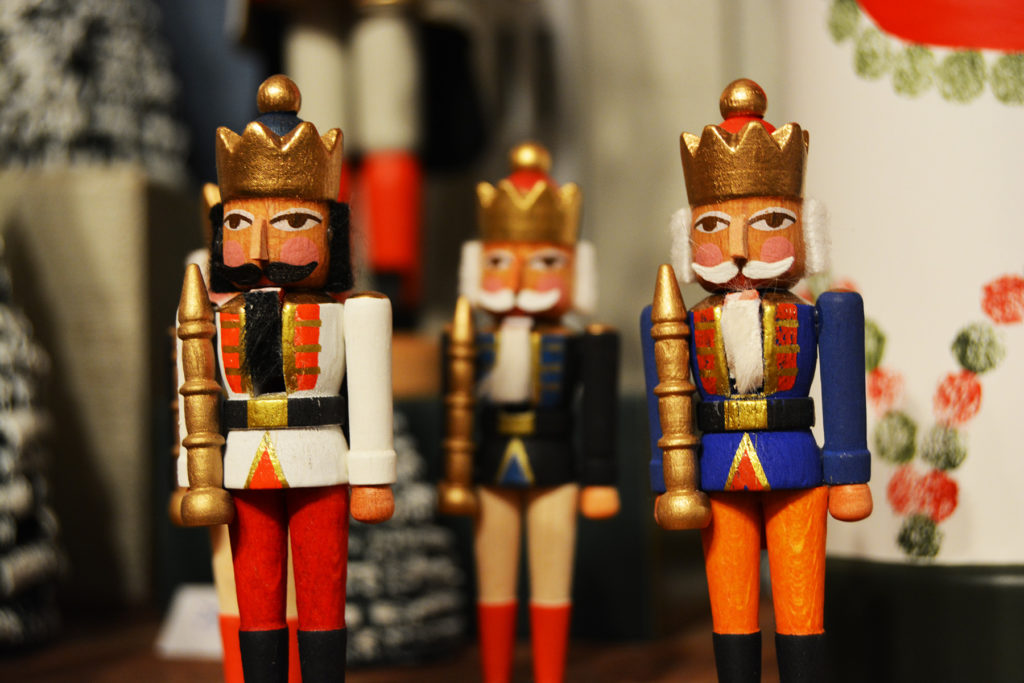
While each town’s Christmas market is unique in one way or another, most incorporate the same fundamental staples. Visitors peruse row upon row of wooden booths, each belonging to various proprietors offering up their unique goods for sale. Craftsmen sell one of a kind trinkets, woodworkers display handcrafted nutcrackers, and glassblowers showcase their delicate ornaments. Culinary options are hearty and plentiful and a draw in and of themselves. Common across all markets are glühwein, a bone-warming hot spiced mulled wine, sizzling sausages, roasted nuts, and some local variety of cookie.
As the sun sets, hundreds of shimmering lights and candles create a magical atmosphere and a large, beautifully decorated tree typically stands as the focal point in each town. In the background choirs singing traditional yuletide carols perfectly encapsulate the Christmas feeling, completing the entire experience like an expertly tied bow on top of a beautifully wrapped gift.
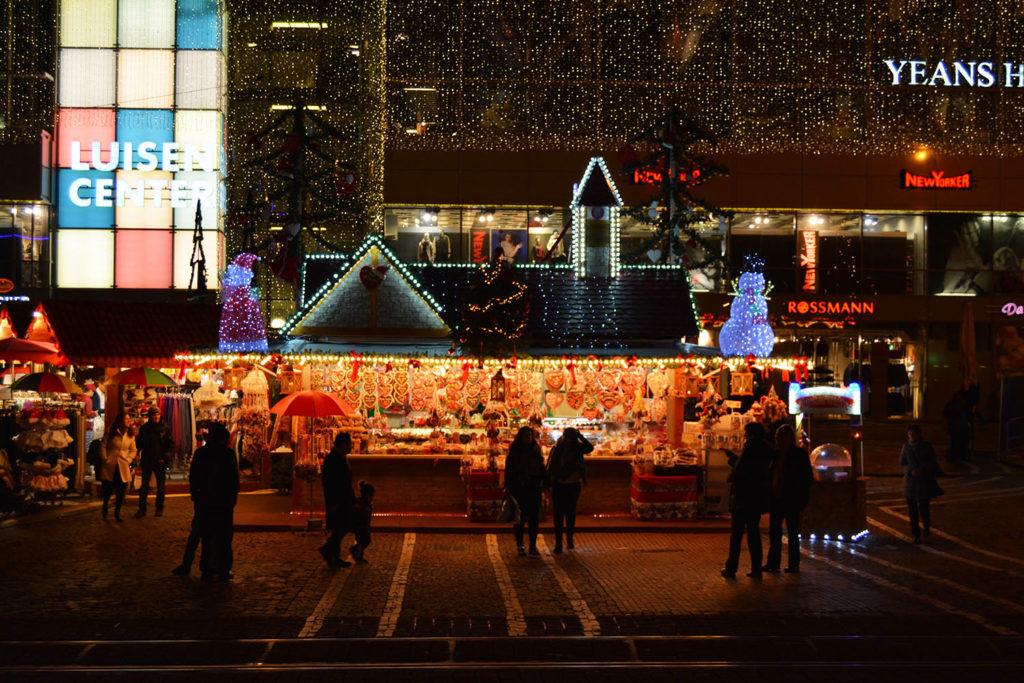
While a great spot to stock up on authentic and unique gifts for ‘whatever you celebrate in December’, the Christmas markets in Germany are also a social gathering spot for locals, especially after the work day ends. Rides such as carousals and Ferris wheels are also typical, providing fun for visitors of all ages.
This year, we took the time to visit a number of markets along the Rhine and Neckar rivers and put together an easy to mimic one-week itinerary of Christmas markets in Germany, providing any first time or expert Christmas marketeer a chance to experience markets big and small and enjoy a variety of hyper-local cuisine, customs and traditions.
Frankfurt
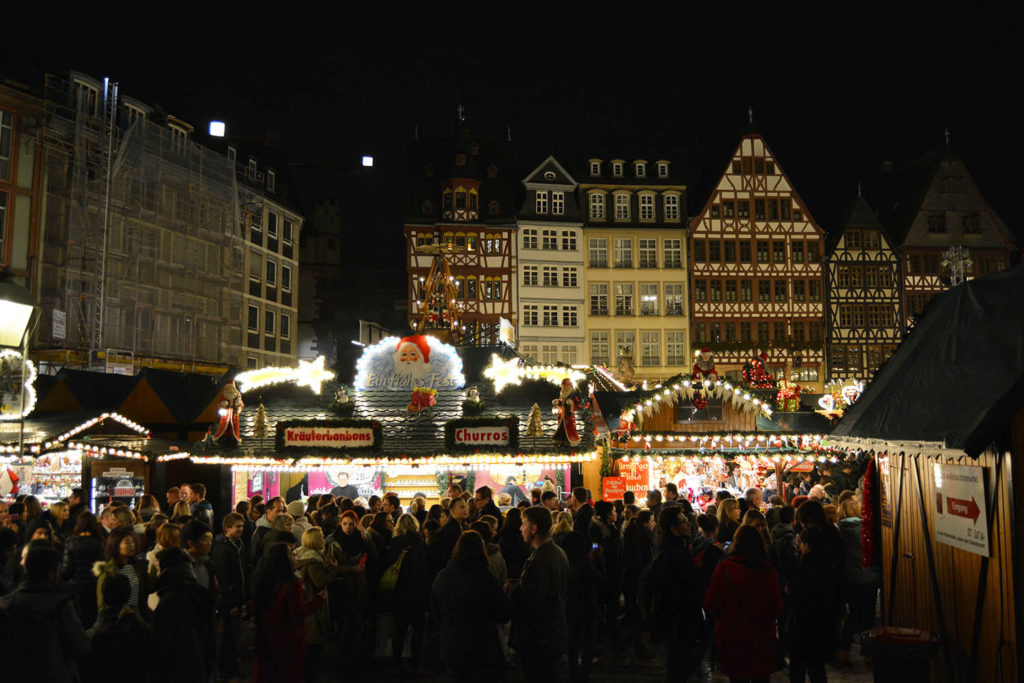
Frankfurt is often overlooked by travelers in favour of more iconic German cities like Munich or Berlin, which is a shame as the city has a lot to offer, particularly in the areas of culture and gastronomy. It’s also a central hub, making it easy to get to other areas of country.
The Christmas market in Frankfurt winds from the Hauptwache station through Paulsplatz to the centre square of the Römerberg district, set against beautiful backdrop of German Gothic, Neoclassical, and modernist architecture. Said to be one of the oldest Christmas markets in Germany, the Frankfurt Weihnachtsmarkt can trace its roots back to 1393, with its tradition and history almost palpable as you traverse the busy market lanes.
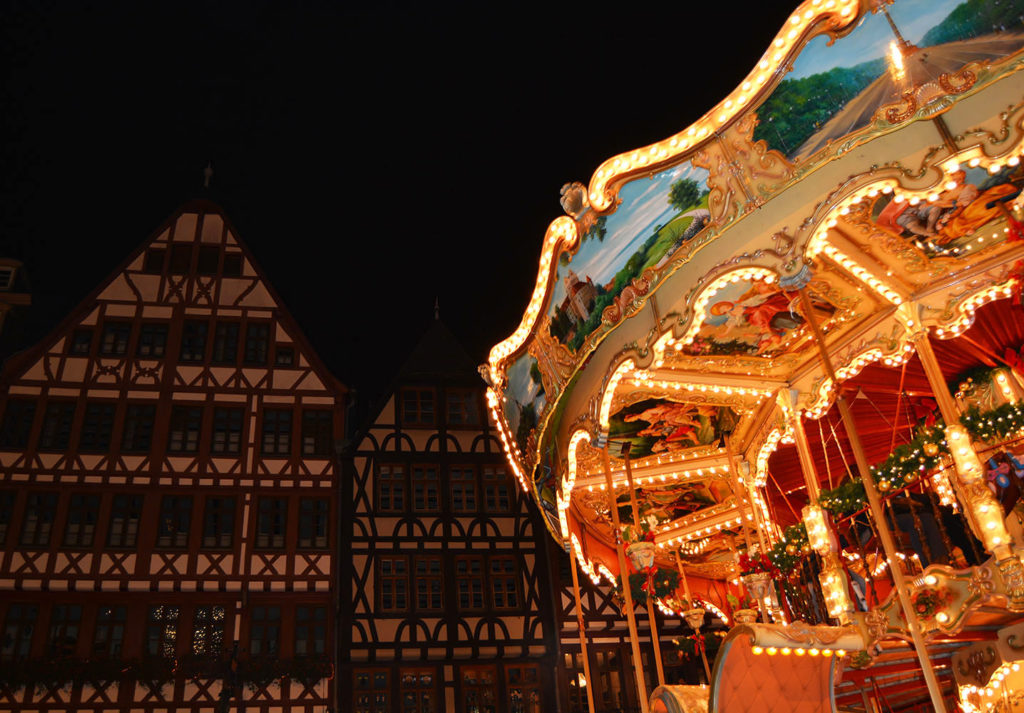
In the Römerberg, an ornate double decker carousel is enjoyed by both kids and adults alike, while many others opt to enjoy a cup of glühwein in close proximity, taking in an array of festive sights and sounds. The nearby market in Friedrich-Stoltze-Platz caters more to adults with many booths in close proximity selling a variety of drinks, including glühwein, beer, and sparkling wine.
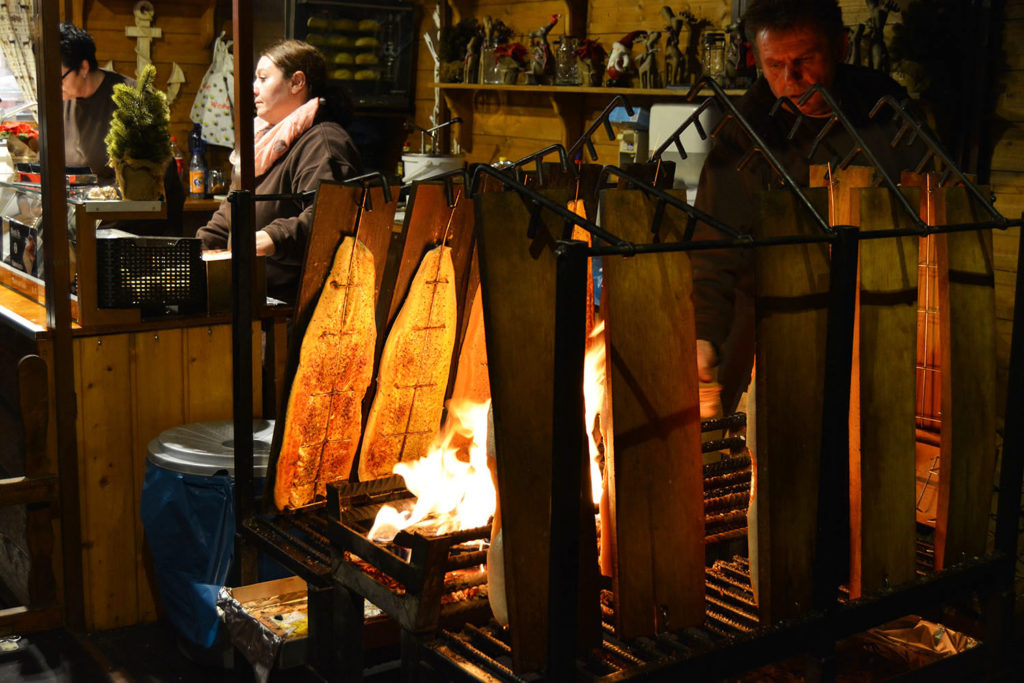
Food options are abundant including all the usual suspects, but also unique specialties such as wood fire salmon (Friedrich-Stoltze-Platz) enjoyed as a sandwich with dill and mustard sauce, marzipan pastries called Bethmännchen, and miniature candy figures known as Quetschemännchen.
Darmstadt
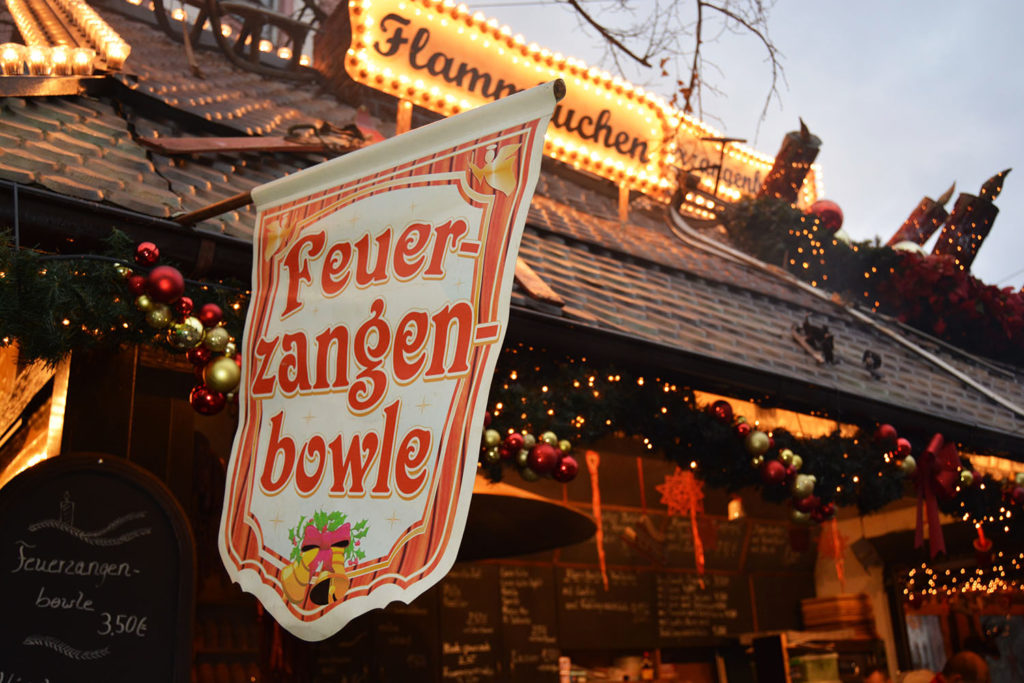
Darmstadt is often overshadowed by its neighbour, Frankfurt, which lies about 20 minutes to the north but is a great addition to any Christmas market itinerary. Known as the City of Science, Darmstadt boasts many technology companies and institutions, making the area relatively international.
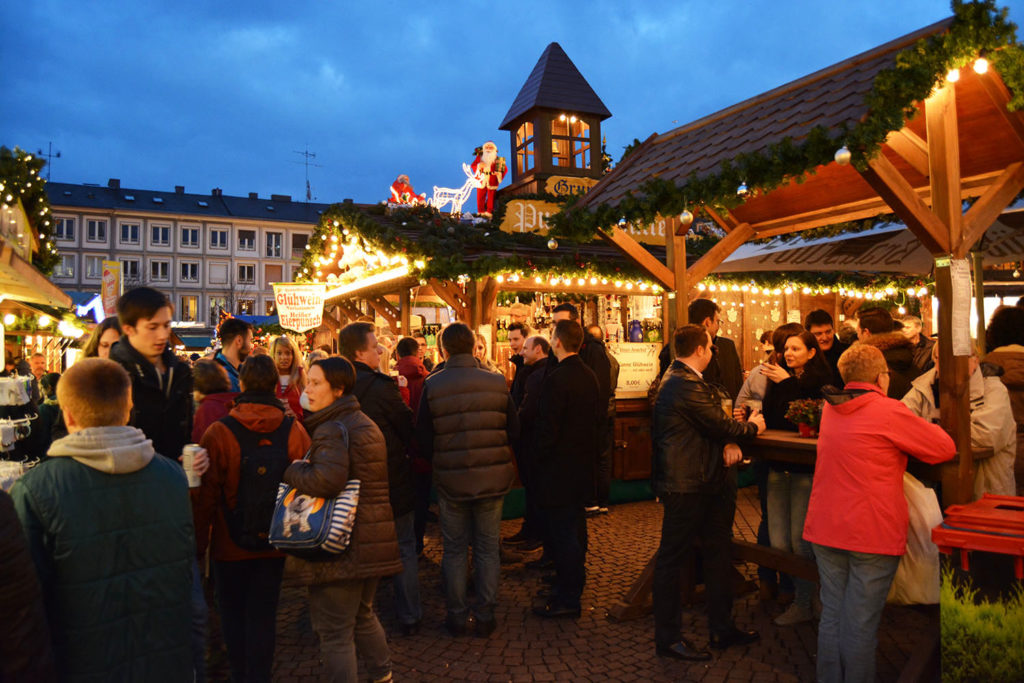
The Darmstadt Weihnachtsmarkt is a smaller scale relative to Christmas markets in larger cities, but exudes an abundance of charm. The market extends throughout the town, with stalls set up at many prominent squares, making Darmstadt a city of Christmas markets. The heart of the market, though, is in the grandiose Marktplatz, the oldest plaza in Darmstadt.
With stalls from the town’s sister cities, Darmstadt’s Christmas Market has a distinctly international flair; elements from Liepaja in Latvia, Gyoenk in Hungary, and Brescia in Italy are all represented, amongst others, providing an opportunity to pick up some truly unique items.
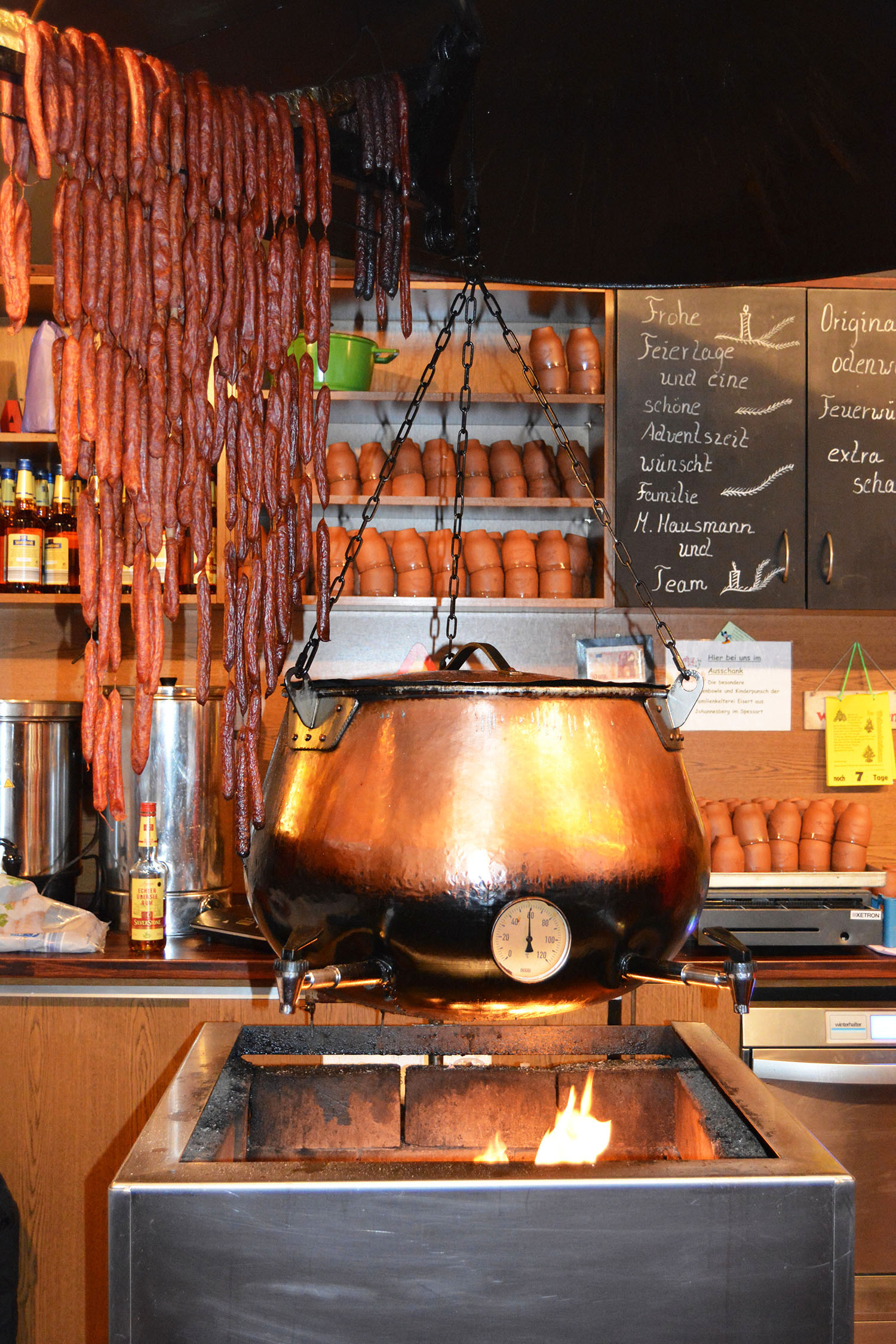
Although difficult to pronounce, the must-tries at the Darmstadt Christmas Market are flammeküeche and feuerzangenbowle. The former is a wood-oven baked thin-crust pizza / tarte with crème fraîche. The latter is a traditional drink made by lighting rum-soaked sugar loaf on fire and letting it drip into a vat of mulled wine. The best of both can be found at the Hausmann booth located at the corner of the Marktplatz toward Ernst-Ludwigs-Straße. Travel a little further into Ernst-Ludwigs-Platz and you’ll come across another item totally unique to Darmstadt: glühbier. While a few varieties now exist, Darmstadt uses the Belgian cherry beer “Liefmanns” as a base, heated and spiced like the more traditional glühwein.
Cologne
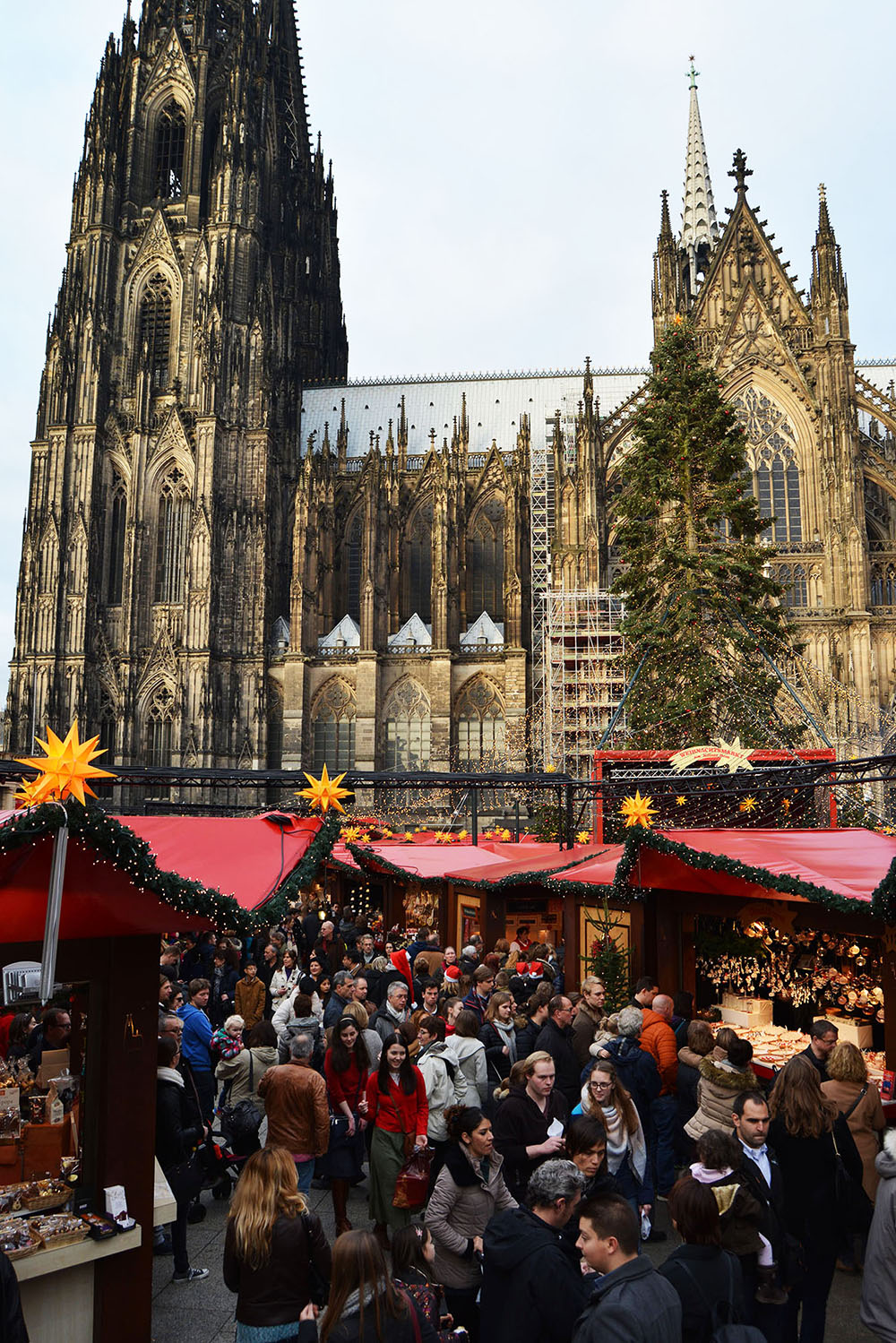
Heading into the Rhineland, Cologne is a prominent city that is popular with locals and tourists alike, drawing millions of visitors a year. While immediately recognized by its iconic gothic cathedral, the Kölner Dom, the city is also renowned for its university, one of the oldest and largest in Europe.
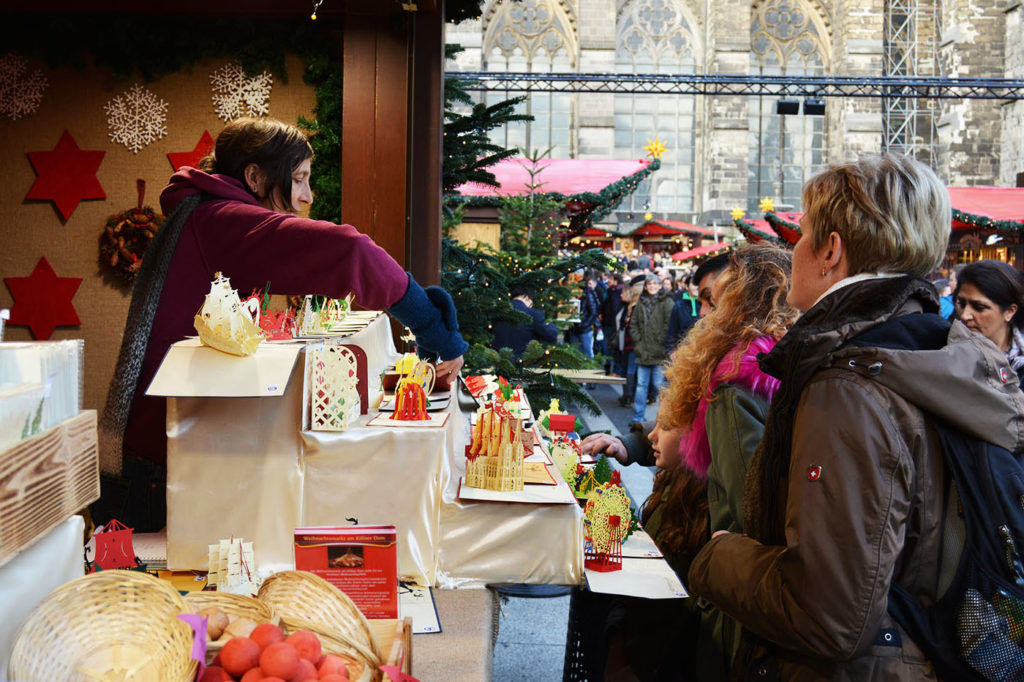
Cologne actually boasts seven Christmas markets scattered throughout the city, but the most prominent is in the town’s Altstadt. Many tourists spend their time in the market just outside of the main train station at the foot of the Dom, which has many of the standard market elements but is very busy and noticeably less authentic (though not without a few gems like the handmade 3D cards above). Head a little farther to the enchanting Alter Markt, which, as legend has it is run by house gnomes or Heinzelmännchen. Here, with medieval style, local artisans dressed in fair tale garb showcase their handmade items and serve a range of food and drinks.
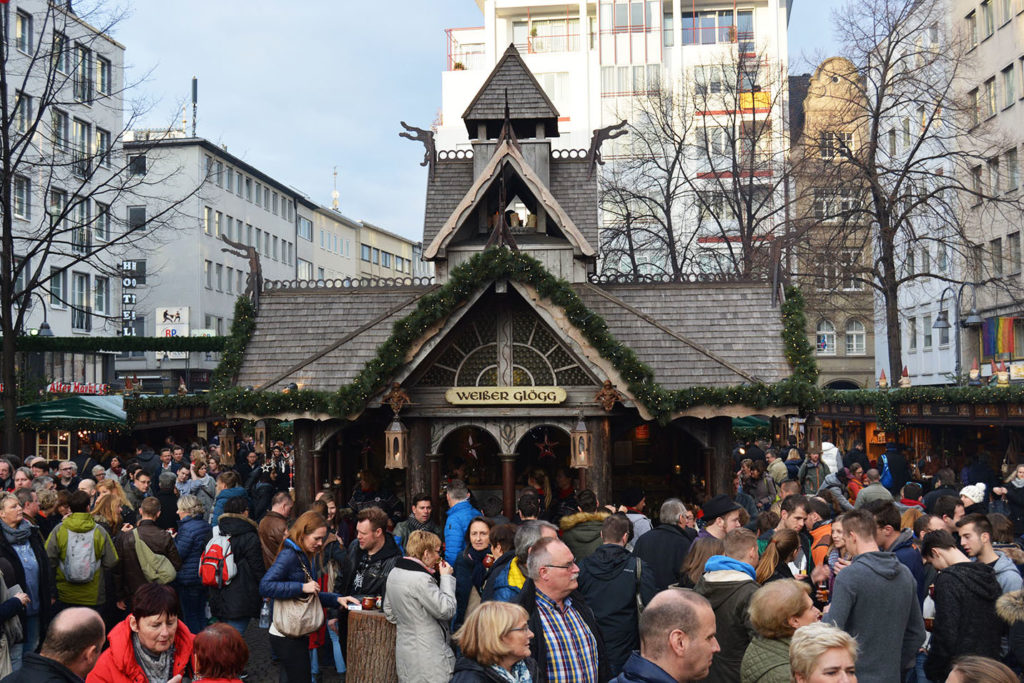
At the end of the market, in the Heumarkt, you’ll find a double decker wooden house where you can catch a great view of the surrounding market, have a drink, and watch visitors enjoy a large skating rink erected for the festival. If you need a break from the crowds, walk through the old city toward the Rhine River where heated patios and traditional restaurants line the riverbank. You can also get a great view of the Great St. Martin Church rising above Cologne’s old city.
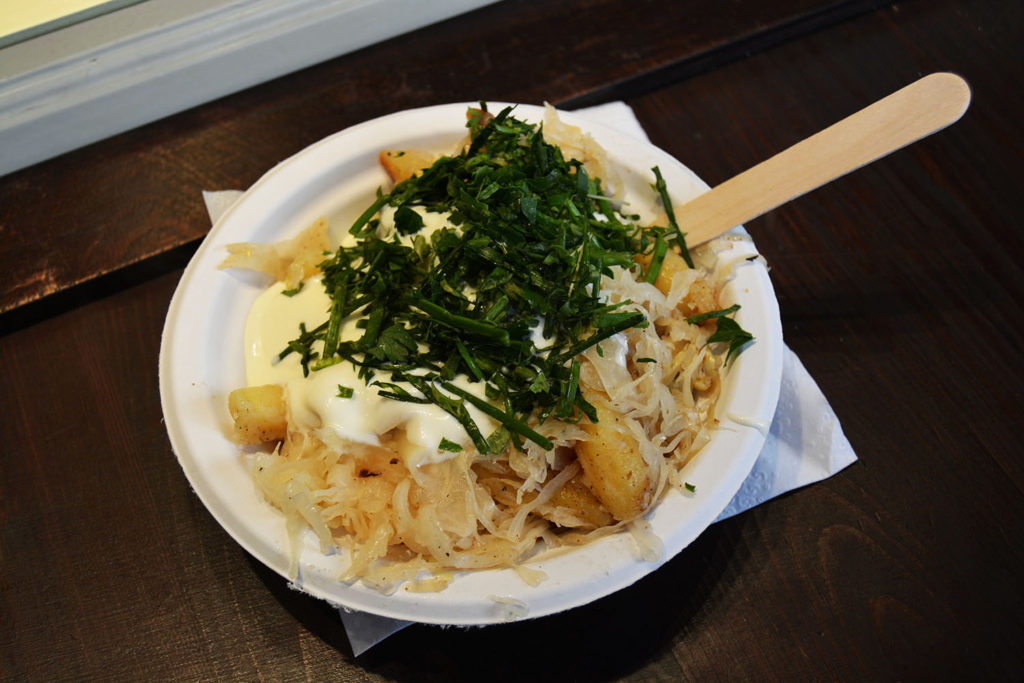
Back in the market, culinary options are plentiful. We recommend trying cinnamon cookies (zimtsterne), dumpling noodles (schupfnudel) smothered with sauerkraut and sour cream, and, the incredibly medieval half-metre sticks of grilled meats.
Dusseldorf
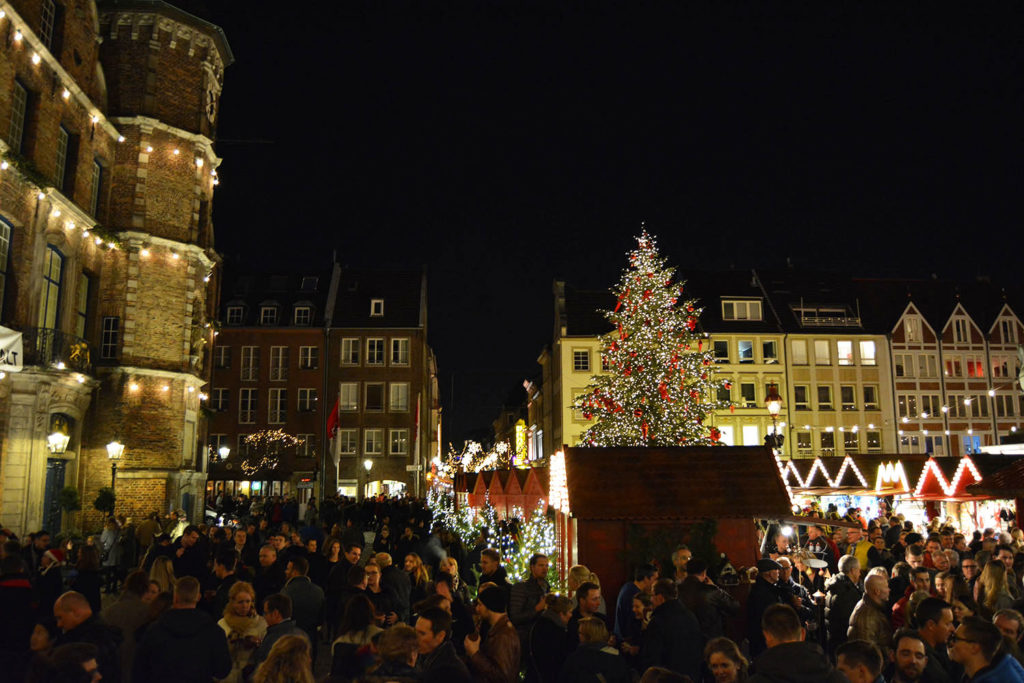
While physically close to Cologne, Dusseldorf is miles away in terms of culture and lifestyle. In fact, the historic rivalry between the two cities is intense and is every bit as evident in today’s day and age. A hub for finance, insurance and mobile conglomerates, Düsseldorf has lots to cater to the lifestyle of local business leaders, including opera, fine arts, dining, and upscale shopping along the famous Königsallee (or King’s Avenue).
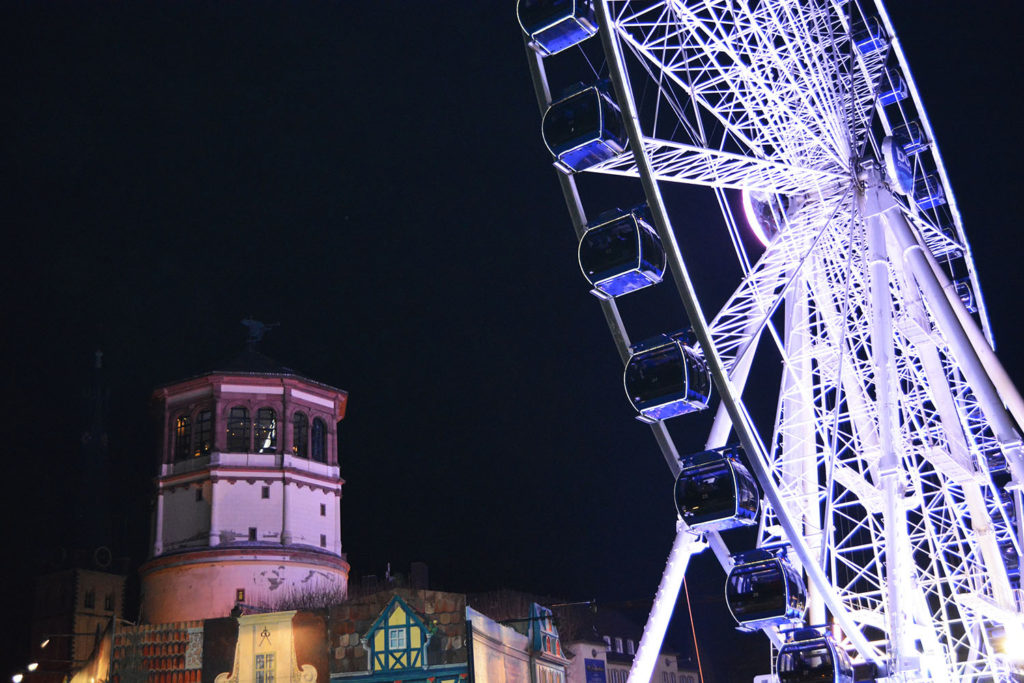
True to its rivalry with Cologne, Dusseldorf also showcases seven distinct Christmas markets. Set a bit of a hike from the Hauptbahnhof, one of Dusseldorf’s most prolific Christmas Markets is located in the Burgplatz, right in the heart of the altstadt. The Castle Tower provides a lovely backdrop for the rows of stalls, bursting at the seams with interesting toys and trinkets.
An enormous Ferris wheel reminiscent of the London Eye provides incredible views over the market, the Rhine, and the city itself. The piece de resistance is a gigantic Christmas tree decorated with classic red bows and thousands of lights.
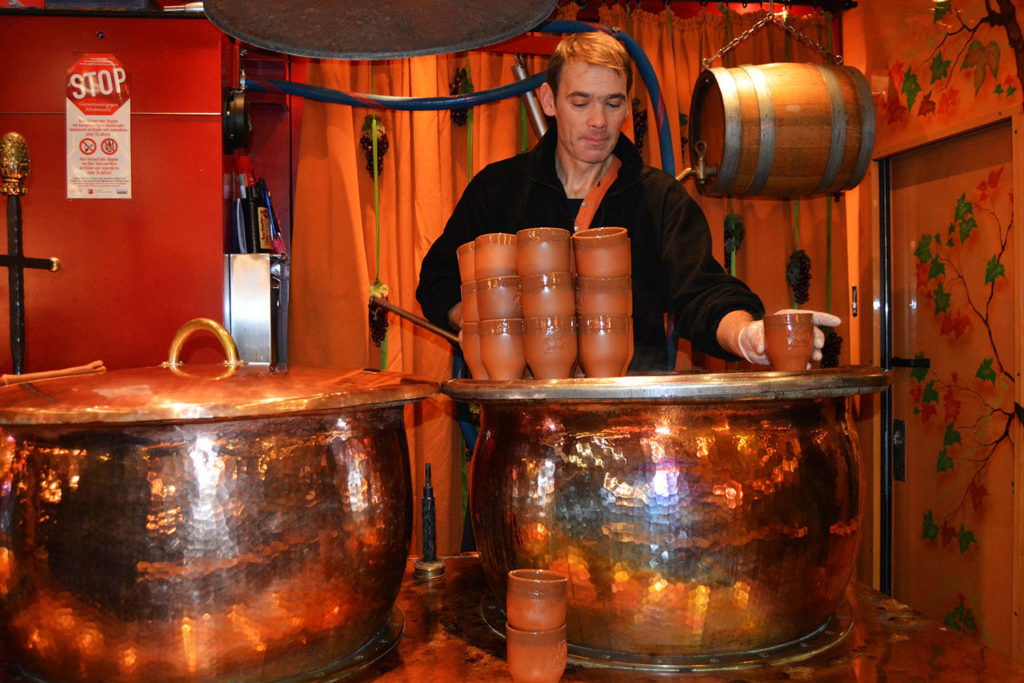
If you need a snack at this point, why not sample a traditional bratwürst, served on a small bun with mustard. Afterwards, head towards the Altes Rathaus where hundreds congregate in the Marktplatz sipping piping hot mugs of feuerzangenbowle while catching up with friends. If you’re feeling a bit more daring, head over to the Haus Zum Helm and order a shot of Killepitsch from their outdoor takeout window. Not entirely dissimilar from Jagermeister, this herbal liqueur consists of over 98 organic herbs, berries, and fruits, ripened in clay containers. It has been voted as one of the best spirits in the world and will not disappoint.
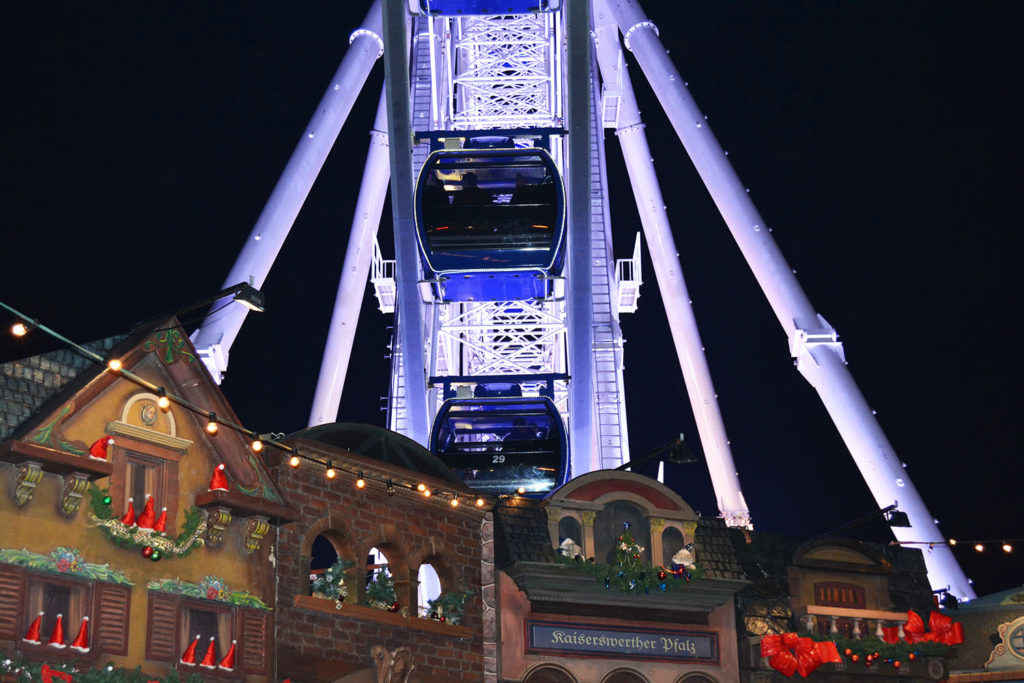
On weekends be prepared for market visitors to spill out into nearby streets to continue their evening at one of the many bars and clubs in Düsseldorf’s old city.
Wiesbaden
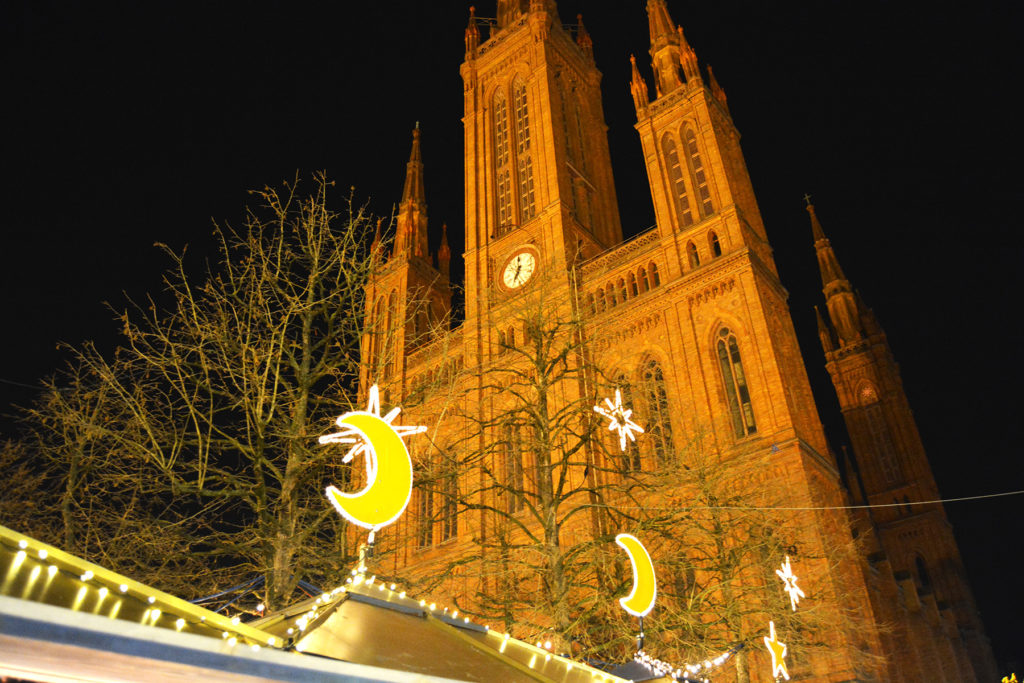
While Wiesbaden might not be on many tourist routes, the capital of the state of Hesse is worthy of a visit all year round. The city is wonderfully quaint yet boasts beautiful outdoor space, interesting landmarks like the Kurhaus and Russian Orthodox Church, a hot springs spa, and excellent wines made in the region.
Wiesbaden’s Sternschnuppenmarkt, or Twinkling Star Market, takes over the Sclossplatz, the square nestled between the Rathaus and the Marktkirche. The setting is visually stunning with large light installations in the shape of lilies, a tribute to Wiesbaden’s coat of arms, sparkle high above the crowds. Over a hundred stalls, many featuring locally produced items like small wooden toys and delicate ornaments, spill out into the street as market-goers venture from stall to stall.
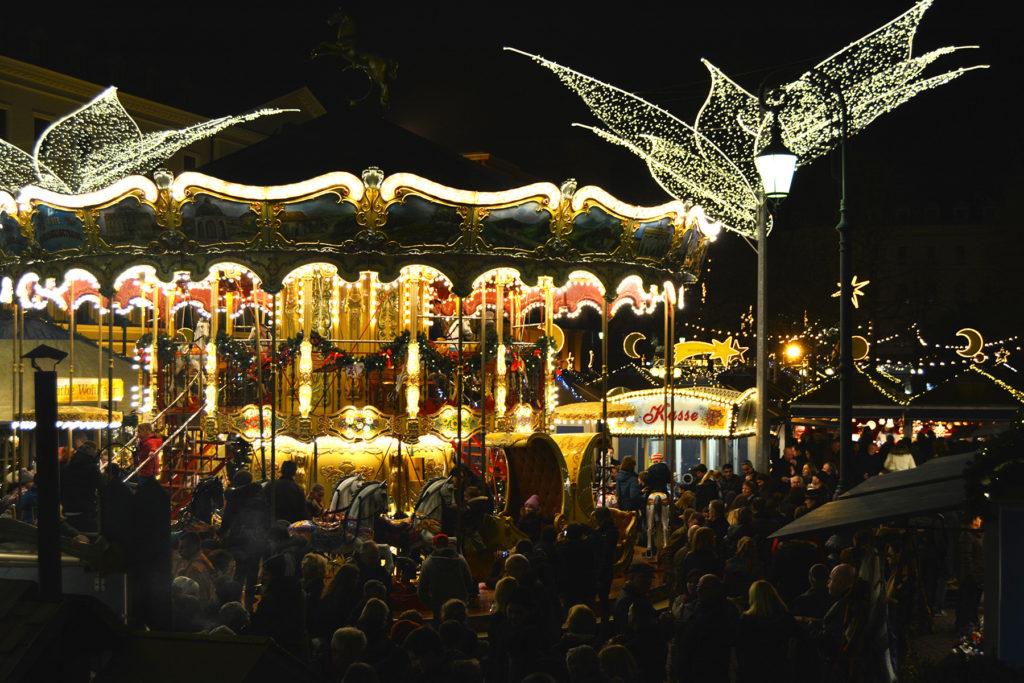
Like many of the markets, Wiesbaden features rides for children including a Ferris wheel, a carousel, and a train that snakes around the Sternschnuppenmarkt. A skating rink set up in the nearby Warmer Damm park provides a festive activity for visitors of all ages and a wooden ski lodge offers delicious foods and tasty drinks in a cozy setting. Follow the lead of the locals and enjoy a glass of sparkling wine from Henkell Trocken, which has its head office in Wiesbaden.
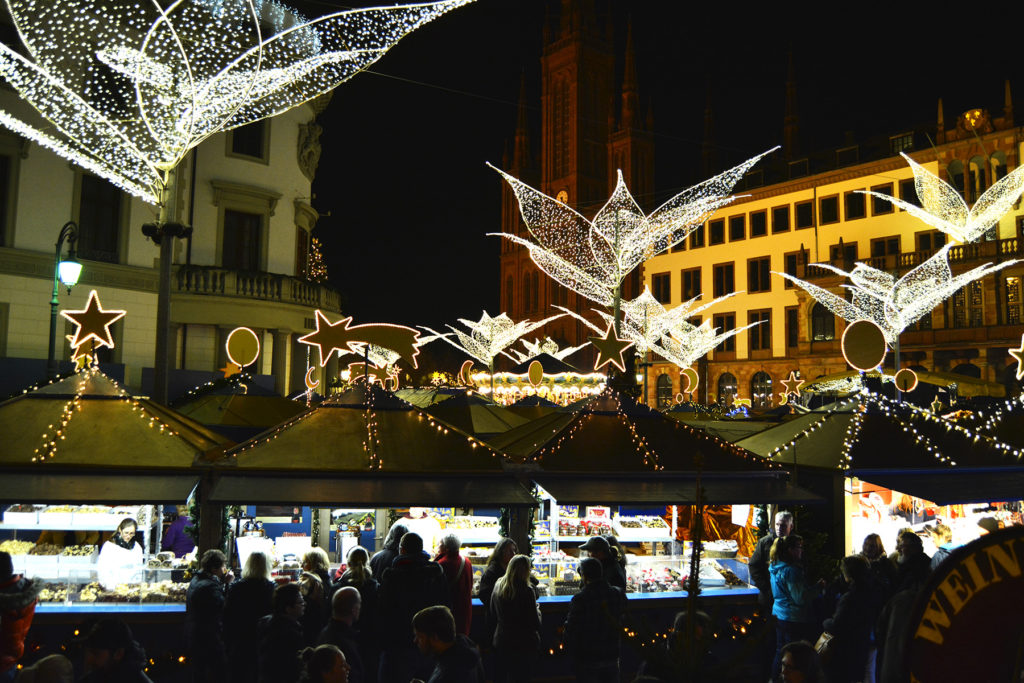
Wiesbaden is located in a wine region so make sure to try some local wines at the Kesler stall, where you’ll see groups of friends sharing a bottle of wine or a thermos of glühwein. A specialty of the market is the white glühwein, made from local white wine, which is drier and less sweet than its red counterpart. For something unique try a wild bratwurst, sausage made from boar or deer.
Mainz
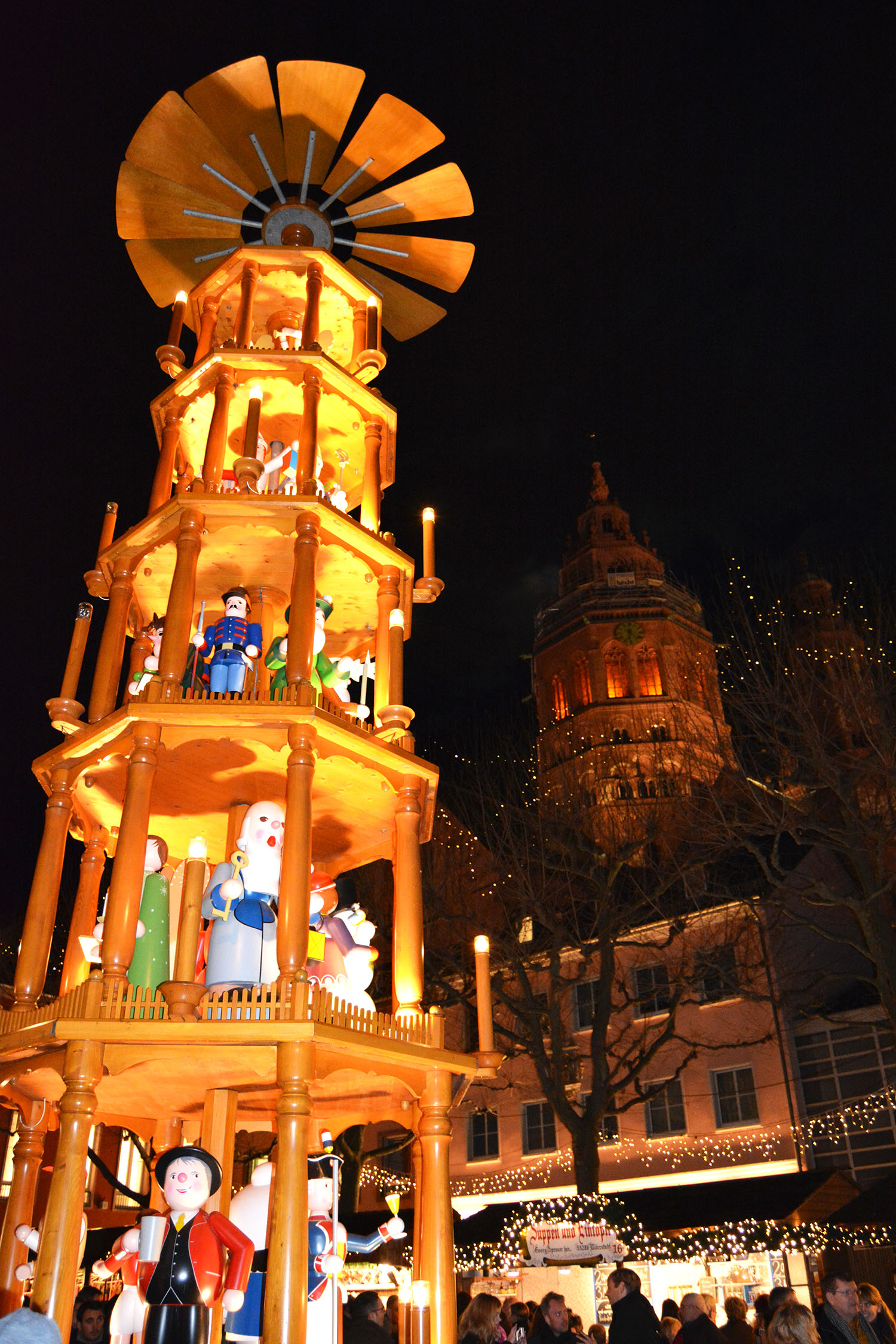
Located just across the Rhine from Wiesbaden and thirty minutes from Frankfurt, Mainz is the capital of the Rhineland-Palatinate state. Once the northernmost part of the Holy Roman Empire, the city has a long and rich history, with noticeable remains including an aqueduct. Mainz is world renowned as the place where Gutenberg invented the printing press.
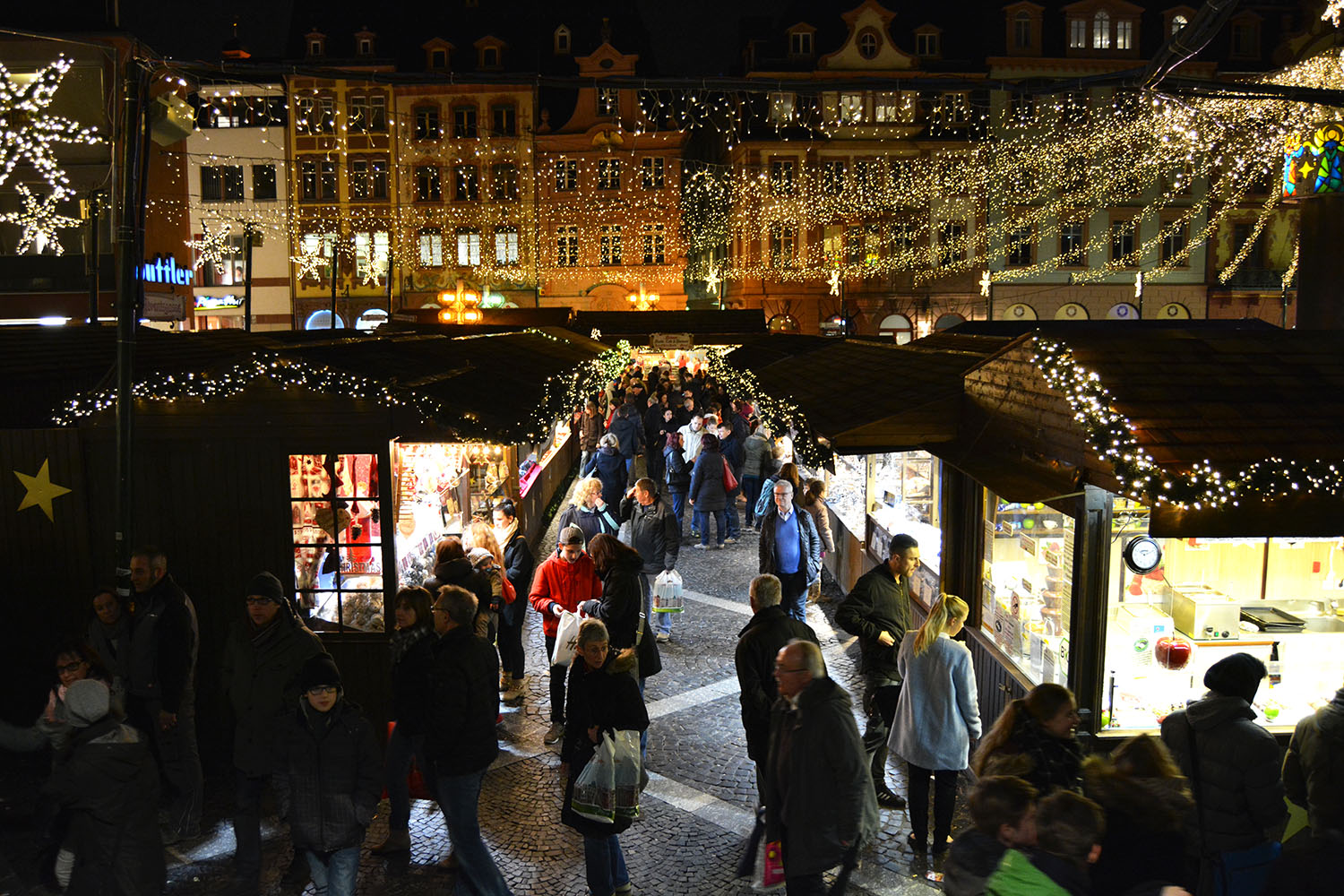
The Mainz Weihnachtsmarkt is a breathtaking market set against the backdrop of the thousand year old Mainzer Dom, or St. Martin’s Cathedral, in the stunning old town. Twinkling lights cascade over the market creating a wonderfully festive experience for all who visit. Multi-level Christmas pyramids are common across all Christmas markets but the one in Mainz is something to behold with five spinning storeys featuring figures in the style of the traditional wooden ornaments.
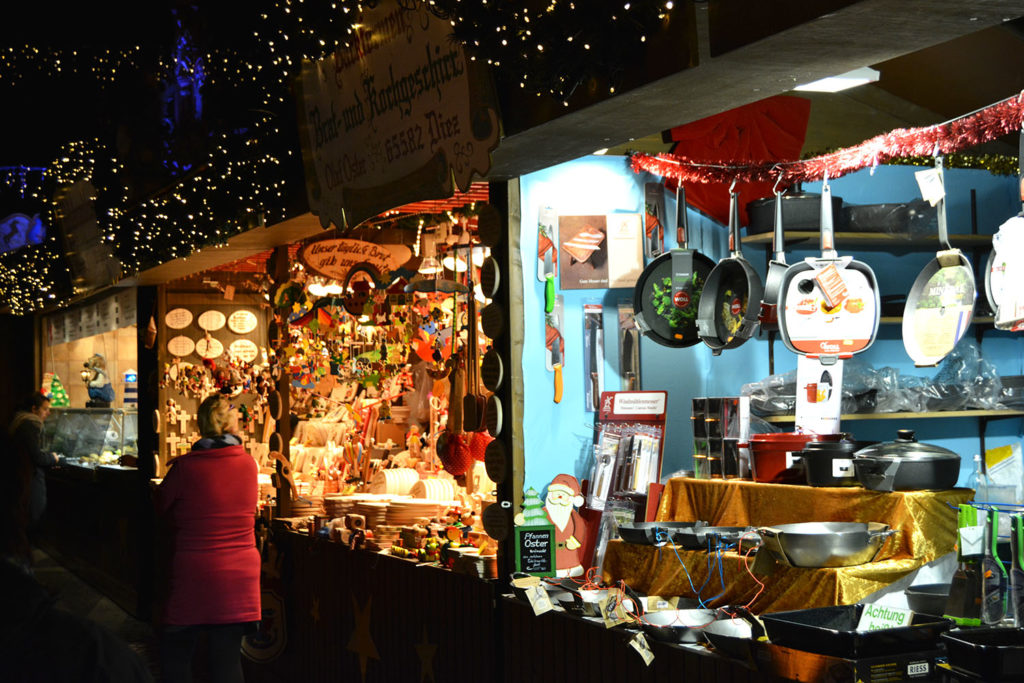
Make the experience even more memorable by grabbing one of a dozen or so small wooden cabins that are available for market-goers to enjoy a drink in, like your own private bar. Some are larger with barrels seats around a table while others you can just stand in, but both will certainly help to get you in a festive mood and out of the cold.
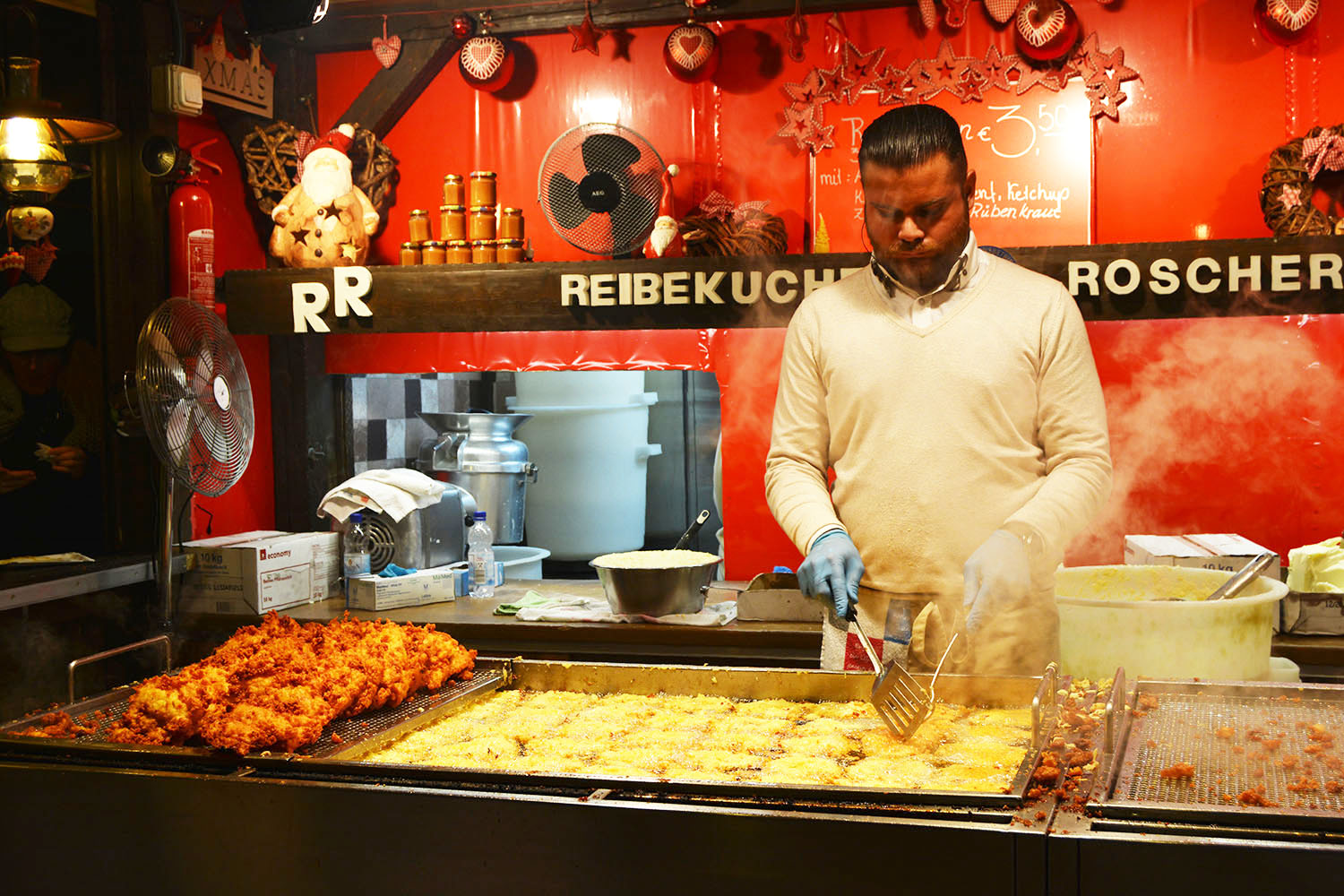
The food at the Mainz Christmas Market does not disappoint. Large flamekuchen are pilled high with roasted vegetables, pork sandwiches are made from a spit-roasting pub, and the reibekuche, potato pancakes, are the best and crispiest anywhere. White glühwein is also featured in the Mainz market and if it’s too bitter, sugar dispensers are available to sweeten it up.
Stuttgart
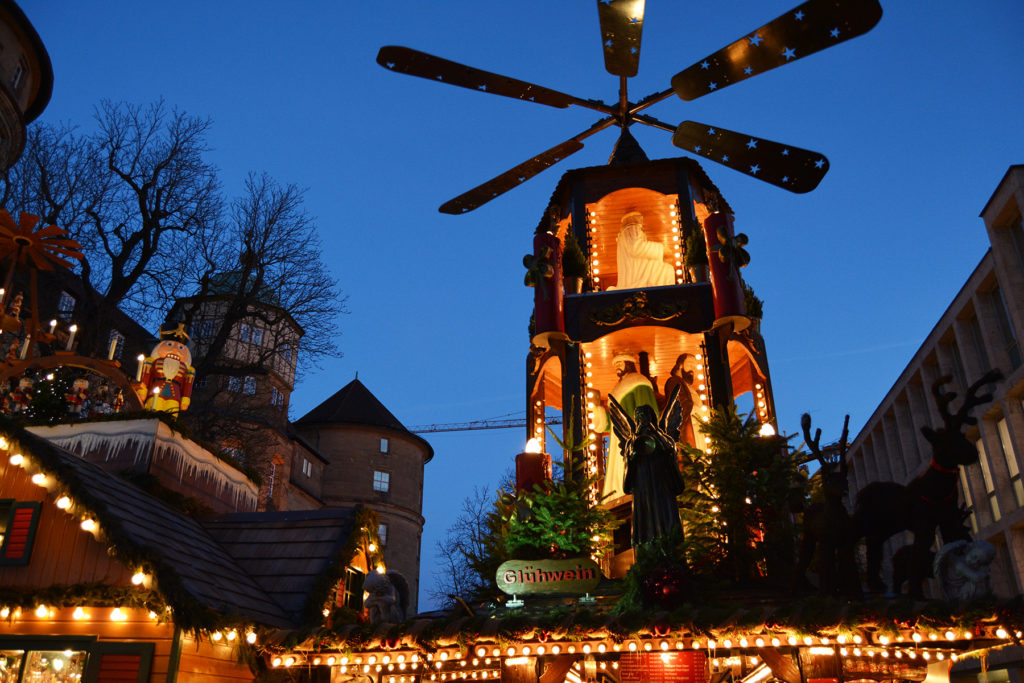
Stuttgart is not only the capital of the region of Baden-Württemberg, it’s a cultural hub in Germany. Beautiful architecture, plentiful outdoor space, and high quality art offerings, Stuttgart is a wonderful city to include on any traveler’s itinerary.
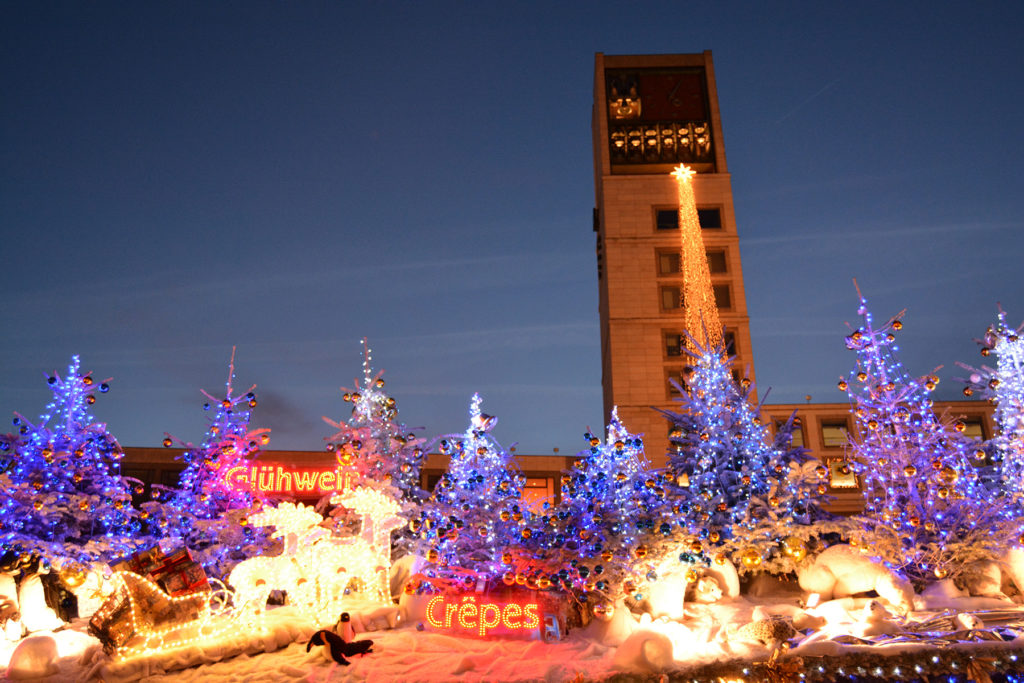
The Stuttgart Weihnachtsmarkt has a long history, dating back to at least 1692 when it was first mentioned, and a busy present, attracting upwards of 3.5 million visitors every year. The nearly 300 stalls sell mostly original and one of a kind items, and the roofs are all elaborately decorated as proprietors all look to win the coveted ‘most beautiful stall’ award. Head to the top of the Kunstmuseum or the town hall to get a spectacular view of the different parts of market.
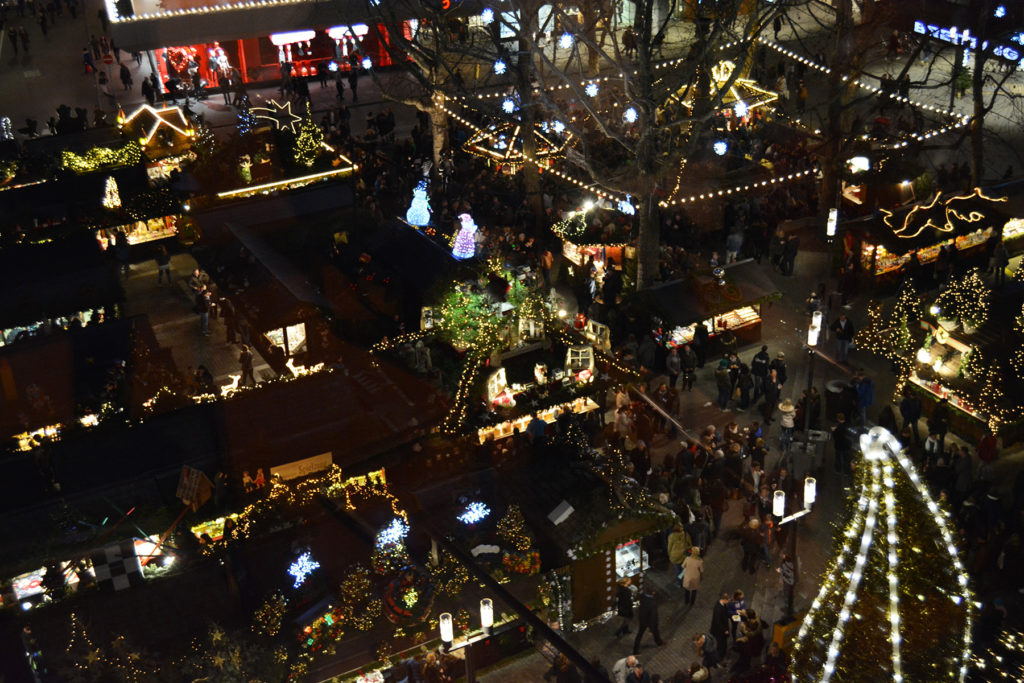
One of the most magical spots in the market is the square tucked away in the Altes Schloss. This 16th century Renaissance style palace is brilliantly lit during the Christmas season with lights and large glowing stars. A free yuletide themed concert is performed here most evenings at 6, making the surroundings even more festive. A smaller market specifically for children is close by in the Schlossplatz with rides and toys, but without the densely packed crowds that can make looking after a small child unnerving. The children’s market also features a steam railway that takes them through a miniature fairy tale town.

Food is a big part of the Stuttgart Christmas Market and you’ll find something excellent to eat everywhere you turn. Local specialties include spätzle, lebkuchen, bratwursts, grilled fish on a stick, and delicious cookies called springerle that have a hint of anise and which are made only for the season. Be sure to pick up a delightful marzipan pig as well, which is given as a token of good luck for the new year. If time permits, take the train to nearby Esslingen, which boasts a uniquely Medieval themed market that is a favourite across all of Europe.
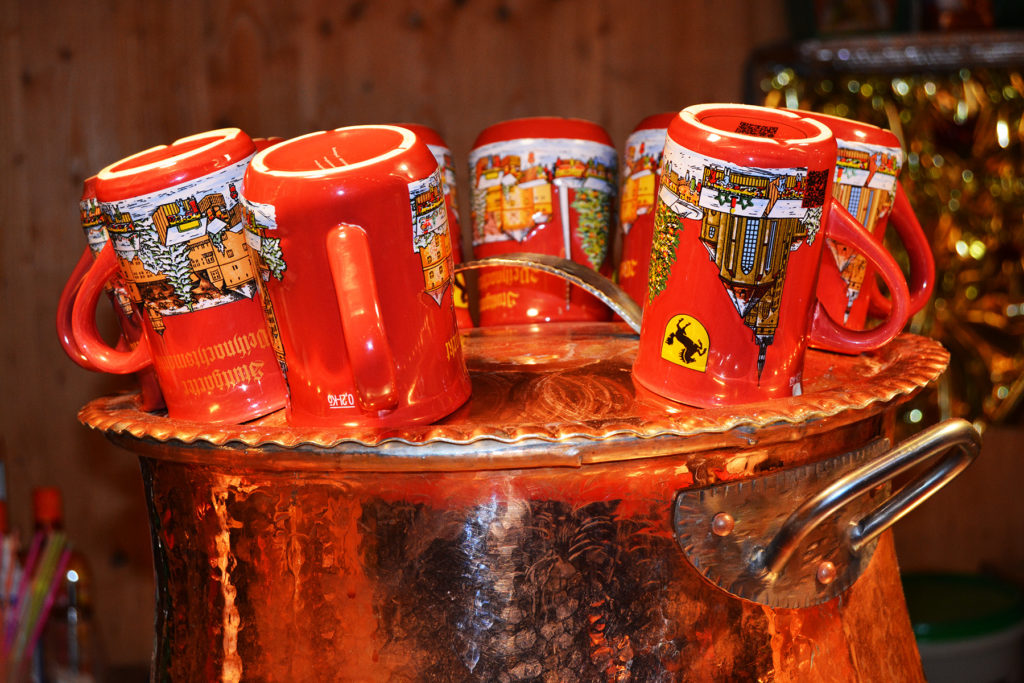
While this list is far from comprehensive, it features seven iconic markets that showcase the best of Germany and its historic Christmas traditions – all easily accessible for anyone looking to take a quick trip to mark the season. See below for a map of these and others en route that are definitely worth the visit. If you’ve been to other Christmas markets or have a favourite German Christmas tradition, please share your tips in the comment section below.
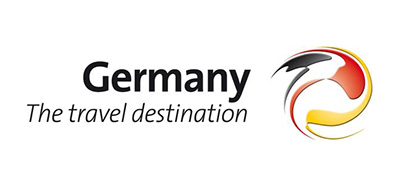 For more on general travel to Germany or Christmas markets in Germany, visit Germany, The Travel Destination, or check out #JoinGermanTradition on Twitter and Instagram. This article was produced in partnership with the German National Tourism Board.
For more on general travel to Germany or Christmas markets in Germany, visit Germany, The Travel Destination, or check out #JoinGermanTradition on Twitter and Instagram. This article was produced in partnership with the German National Tourism Board.
Photos for “Christmas Markets in Germany” courtesy of Departful, JP Bervoets
Make your next trip the best one.
Departful is a full service travel agency creating truly exceptional travel experiences that are 100% personalized to you. Wherever you’re going, whatever your interests, we help you plan the perfect trip.
Lauren
Lauren co-founded Departful in 2012 and is the Managing Director of Departful Media. Since then she has worked between North America and Europe and has published content in partnership with a variety of tourism boards and businesses based around the world. Lauren is currently based in Toronto, Canada.
2 Comments
Add comment Cancel reply
This site uses Akismet to reduce spam. Learn how your comment data is processed.


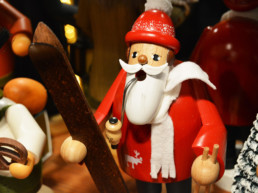
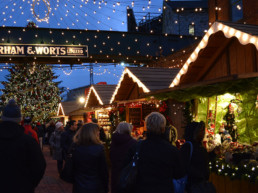
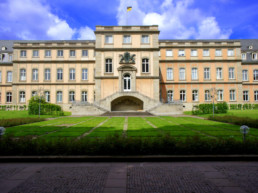
Seen one christmas market, seen them all. Seven in arow is way too much!?
Germany is one wonderful country..last time I visited, I went to a market in Frankfurt.